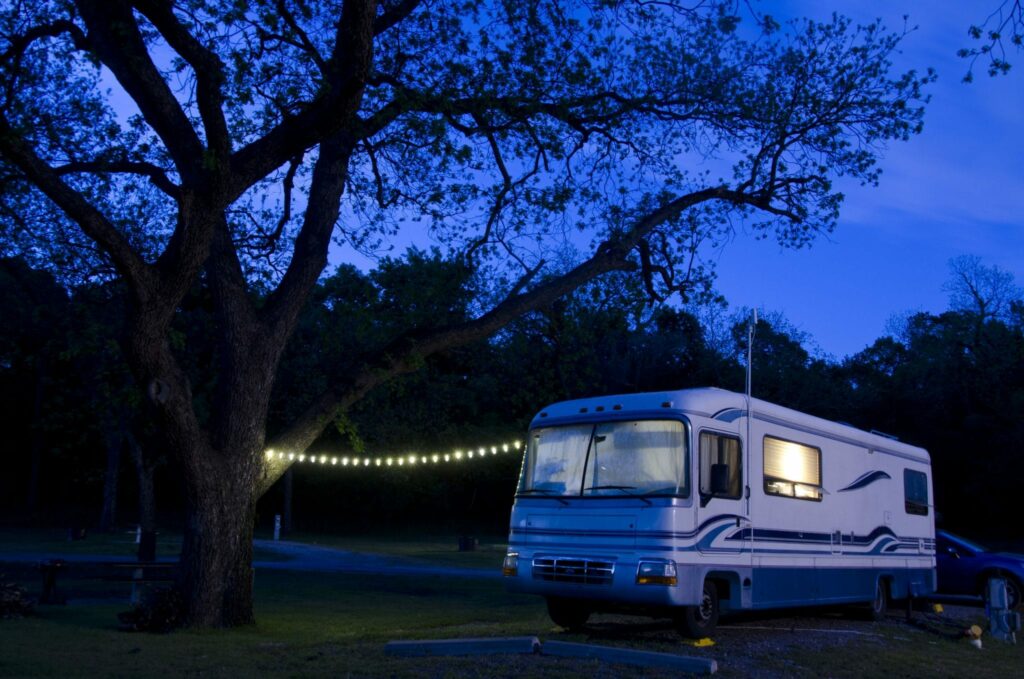Outdoor Lighting & the Environment:
How to Choose RV Lights that Protect Wildlife (& Us)

Outdoor lighting — like safety, display, awning, and/or string lights — can make people feel safer at night, help them see in the dark, add visual appeal, and make it possible to enjoy an evening under the stars.
But what’s the connection between outdoor lighting and the environment? And what can we do to reduce the effects of artificial light on our ecosystem?
In this blog, we’ll share how outdoor lighting impacts our ecosystem, as well as ways you reduce light pollution and minimize wildlife disruption — all while adding beautiful and functional lighting to your RVs.
The Problem
Light pollution is hurting our wildlife.
Light pollution is defined as “the inappropriate or excessive use of artificial light,” or light that’s produced from electricity. And while many of us have grown used to the brighter night skies and fewer visible stars from light pollution, it’s having quite a negative effect on our ecosystem and its living things.
For example, prey can’t hide from predators as easily, since the night sky near cities and towns is much brighter than it used to be. Hatchling sea turtles can move away from their nest and go toward glowing houses. And, of course, insects circle bright outdoor lights, which is annoying to us but potentially deadly for the bugs.
While these are just a few examples, they point to the drastic effects of excessively lighting our homes, outdoor areas, and cityscapes.
Artificial light impacts our sleep and health.
Bright outdoor lighting can cause glare, making RV owners and their guests uncomfortable if they look too closely. But besides the annoying eye strain, artificial light has been proven to impact our sleep quality and overall health.
In a natural environment — when we wake up with the sun and sleep when it’s dark — a hormone called melatonin regulates our sleep, body temperature, metabolism, and more. But having a bright or blue light on while it’s naturally dark outside can interfere with our circadian rhythm and the normal ebb and flow of melatonin.
Over time, this unnatural disruption in our sleep-wake cycle can lead to a host of health issues, including obesity, heart disease, diabetes, depression, and cancer.
The Solution
Install energy-saving RV lights.
Some outdoor lights are incandescent bulbs, which waste up to 90% of the energy they burn — a major contributor to light pollution.
On the other hand, LEDs (light-emitting diodes) are a great option for outdoor lighting since your customers can quickly dim them when warm light is necessary for safety and visibility, then easily turn lights off when they’re not in use. LEDs let you offer an energy-saving solution to your customers, reducing the amount of light pollution and waste they’ll emit at night.
Other ways to minimize harm from light pollution include:
- Only lighting the area that needs it
- Minimize blue light emissions (see next section)
- Be fully shielded from the top and sides (pointing downward)
Along with dimmable lights, you can install timers and motion sensors for your RV lighting. Many people want technology that gives them master control over just about everything these days, so controllable, energy-efficient lighting is a great way to let your customers choose the color temperature and timing of their lights on demand.
Choose low-color-temperature LEDs.
General light pollution isn’t the only thing that can harm people and animals. Research also shows that excessive blue light exposure — which has a higher color temperature and brightens the night sky more than other types of lights — can negatively impact human health and wildlife.
That’s why you should use outdoor lighting that has a color temperature of less than 3,000 Kelvin (K). This will still give you adequate and visually appealing lighting, but with a warm white or yellowish glow (instead of a bright blue light, which can be over 5,000 K).
Low-color-temperature LEDs are warm sources of light that have less blue in them than other types of lighting. To incorporate them in your RV production, you could offer warm white or yellow LEDs for path lighting or awning lights. This will still provide enough outdoor lighting (and an attractive light source) for your customers while minimizing their impact on the environment with lower blue light emissions.
Great manufacturers know that lighting shouldn’t be an afterthought or just a production item. Now that you understand the connection between outdoor lighting and the environment, you can offer reliable, attractive RV lighting solutions that combat the effects of light pollution by protecting wildlife and humans alike.
Are you an RV manufacturer who’s not sure where to start? A cost-effective and innovative lighting partner can help you find a beautiful, functional, eco-friendly solution that you and your customers will love.

********************
Since 1971, Vista has helped manufacturers gain a competitive advantage by merging quality and innovative lighting products with cost-effective pricing and on-time delivery. To learn more, please contact us or connect with us on LinkedIn.

